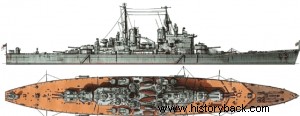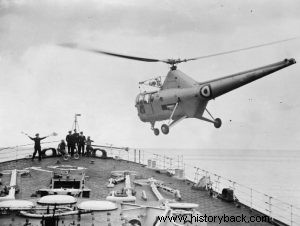
HMS Vanguard began construction in 1941. However, its construction was completed in 1946. Its construction was decided after the cancellation of the construction of the battleships Lion and Temeraire in order to deal with the Japanese heavy cruisers.
For this purpose the vessel had to carry heavy armament, but also to have a high speed. Although there was thought of fitting her with 16in guns, she was eventually fitted with the 15in guns that were available. The vessel had a full displacement of 51,420 t. length 248.2 m, width 32.9 m and draft 10.6 m.
She carried eight 15in (381mm) guns in four twin turrets arranged on the longitudinal axis, two forward and two aft. Secondary armament consisted of 16 dual-purpose (anti-ship and anti-aircraft) 5.25in (133mm) guns mounted in eight turrets, four on each side of the superstructure.
Due to the strengthening of the air threat during the war its anti-aircraft capability was greatly enhanced. Thus the ship came to have 73 40mm anti-aircraft guns. The 15in, 42 caliber guns put a 879 kg projectile at a distance of 36,630 m. The 5.25in guns put a 36.29 kg projectile at a distance of over 22,000 m. Their vertical range exceeded 14,000 m.
The vessel had a crew of 1,893 men. She had Parsons steam turbines powered by eight boilers and produced 130,000 hp. It had four propellers and developed a maximum speed of 30 knots. Carried 4,930 t. fuel.
The ship carried heavy armor based on the all or nothing doctrine. The battleship belt covered the part of the ship from the first forward main gun turret, to the aft end and ranged in thickness from 4.5 – 14in (115-355mm). The armored deck was 5–6in (125–150mm) thick. The armor of the main turrets and their bases varied between 7 and 13in (180-330mm).
The ship was extremely seaworthy and had the most powerful radars of the time for surveillance of naval targets and fire control of her guns. It had a total of 20 radars! HMS Vanguard could travel a distance of 15,280 km without refueling.
The vessel saw no combat action. In addition to some ceremonial trips, he participated in NATO exercises. Retained in service in response to the Soviet Sverdlov class cruisers. In 1959, however, it was decided to dissolve it, since it had been in reserve since 1956. The giant was finally taken to the scrapyard in 1962. It took two years to complete the process.
During the last sailing from the port of Portsmouth thousands of people were there to see for the last time the remnant of another era, the "unfortunate giant" that did not have time to show its value in the open seas where it was designed to dominate.

Plan of 2 sides of the battleship.

HMS Vanguard on a NATO exercise in the late 1950s.

The excellent lines of the ship are evident in this photo. The battleship zone can also be seen.

The battleship photographed from above.


Westland WS-51 Dragonfly helicopter hovers over the battleship.
